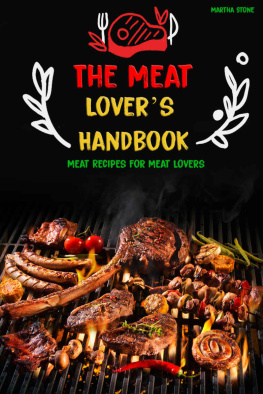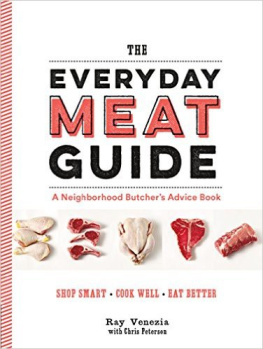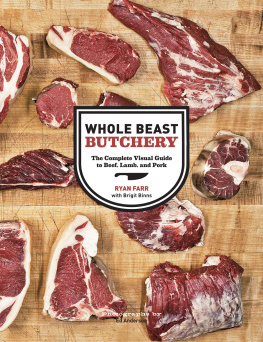TO MY DAD,
FOR MAKING THIS ALL POSSIBLE
Contents
I t all began when my great-grandfather Anthony LaFrieda decided to pack up and move his family from Italy to New York in 1909 in search of a better life. He set up our familys first retail butcher shop in 1922 in Flatbush, Brooklyn. Almost one hundred years later, here I am, a fourth-generation butcher, third-generation meat purveyor, at the helm of a family-run business that has been providing meat to customers in America for decades. My family has worked through wars, the Great Depression, the tumultuous years when New York City was dubbed Fear City, the fall of the Twin Towers, unprecedented hurricanes, and even a pandemic, and were still going strong.
During the late 1990s, when rents in the Meatpacking District skyrocketed and small businesses were being taken over by large impersonal corporations, Pat LaFrieda Meat Purveyors remained in the family and went on to become enormously successful. When my father started working with my grandfather, they were located in a small spot inside a decrepit old building amid the chaos of the Fourteenth Street Meat Market. My dad went from working in extreme conditions with no heat or elevator to a 35,000-square-foot facility in New Jersey, right across the river from Midtown Manhattan, and weve now opened a second facility two blocks away. With close to two hundred employees, we provide more than five hundred thousand pounds of meat a week to retailers, restaurants, and home delivery customers. We are a bridge between meat and people.
Our national meat industry is an intricate yet remarkably efficient system that feeds millions of people across the country. When I joined the business in 1994, no one really cared about where the meat came fromthey just cared about the quality. But the quality is directly linked to how those animals were raised, finished, and harvested.
I first set out to share what I had been learning on the field with my clients many years ago. The more they knew, the better choices they would make for their businesses and patrons. In order to keep them informed on the latest trends and innovations and the industrys ever-evolving new technology and advances, I need to constantly stay up to date on what is happening in our industry as a whole.
Beyond that, my meat purveyor role often extends into consulting, with chefs reaching out to brainstorm what they could put on the menu of their new restaurants or how they could revamp their old menus to attract more customers. Thats how many famous dishes came to be, including the Black Label Burger at Minetta Tavern, the Shake Shack all-natural burger, and our signature Original Filet Mignon Steak Sandwich.
Most people dont know the amount of time, commitment, and work that goes into the piece of meat on their plate. Im here to explain it to you. This isnt your average farm-to-table book. Its not for the faint of heart. I want to take you behind the scenes of each stage of the process: the ups, the downs, the struggles, the accomplishments, and the misconceptions surrounding beef related to everything from our health and the environment to what youre really buying at the store.
What are the real implications of grass-fed beef on climate change? What goes into humanely processing animals at harvesting facilities? Why are grading, labeling, and traceability essential for the end consumer? Whats the beef with eating meat? There are two sides to every story, yet, in the beef industrys case, only one seems to get most of the airtime. I want to help correct this mistake and reveal the side that is usually ignored by the media, which often presents a simplistic, one-dimensional story.
Thats why Glorious Beef is not just about debunking myths; its about sharing the truths behind the industrys story of survival and constant evolution. Its based on what I have seen and experienced on a personal level as I grew up and on a professional level as I came up in the industry myself. Im not here to tell you what to do or how to thinkI want to give you enough information for you to be able to make the right choices for yourself. Its time to bring beef back to its glory, celebrate its history and accomplishments, and shine a light on all it has to offer. This is the industrys story. This is the story of everyone who enjoys that juicy steak on their plate. And, of course, this is also my story, because the meat industry is my home.
I ts three in the morning and Im sitting in the passengers seat of my dads car, heart pounding with excitement as he drives down the Belt Parkway from our home in Bensonhurst, Brooklyn, toward Manhattan. I grab my dads pack of Marlboro Reds lying on the seat between us and take a long and deep whiff. Ive never smoked, but that smell of raw tobacco to this day is my dad, even though he quit years ago; it bathes me in a sense of pure comfort. Wide-awake with anticipation, I look out at the empty New York streets in the dark of the night. Ive driven to work with my dad before, but this time its different. Its 1981, Im ten years old, and my father is going to finally let me stand at the butchers table with him and my grandfather and cut meat for our customers.
We walk into our family shop, Pat LaFrieda Meat Purveyors, on Bleecker Street and West Tenth and, as my dad greets my grandfather and settles in, I go straight for the butcher coats, sliding my arms into one of those all-important white garments and buttoning it up over the several layers of T-shirts and shirts I had carefully put on earlier. Id learned my lesson: if I wanted to make it through the work shift, I knew I had to layer up and keep moving to stay warm in the 36-degree temperatures.
When my dad gives me the signal, I walk over to the six-foot-long butcher table lined with meat that is ready to be turned into the days orders. At ten, I barely reached the table, but I got the boost I needed by stepping onto an old milk crate that propelled me up to the cutting sweet spot where the knives were at a safe distance from my face. And there I stood, flanked by my father at right and my grandfather at leftthe two men I admired most in the worldimmersed in the smell of sweet fresh beef. As I sank my knife into the top round before me, all I could think was, This is it. This is what I want to do with my life.
I was hooked.
But I knew nothing about where the meat on the table came from; I had no idea about all the hard work and sacrifice that went into procuring it, selling it, and delivering it. For a born and raised Brooklyn kid, it was hard to imagine farms filled with herds of cattle, the far-reaching paddocks out west dotted with cows and calves, bullocks and bulls, steers and heifers. I probably didnt even know the terminology back then, but I have come to believe that if you really want to understand something, you have to go to the source, and that source, in our case, is the growers.
Im often asked, Pat, where do you get your cows from? Generally speaking, we do not eat cows. Stay with me. A cow is a female that has had at least one calf. A bull is a mature male used for breeding. These two animals mate and produce calves, which grow into steers and heifers. A steer is a castrated male (prior to castration they are called bullocks) and a heifer is a female that hasnt had a calf yet. So, if you happen to have a piece of high-quality meat on your plate, then you are most certainly eating a steer or heifer, not a cow. Cows will show up in meat products, but mainly lower-quality ones; they dont make the cut when it comes to Prime beef in large part because theyre too old at the time of harvesting.
And who are the growers? The growers are the farmers, the owners of herds of cattle that feed the more than 330 million people in our country. How do they do this? First, they have to identify what type of product they want to sell and where it will go.







